| |
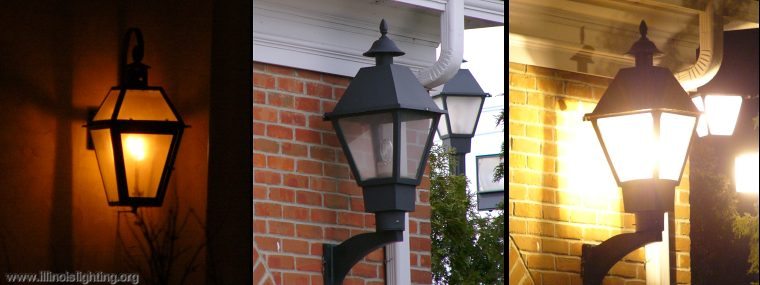
The actual open flame gas lamp on the left puts out around 20 to 40 lumens. Its modern replica in the center features a high pressure sodium lamp (200 watt), which puts out about 20,000 lumens (500 to 1000 times as much light). The result, on the right: Ouch!
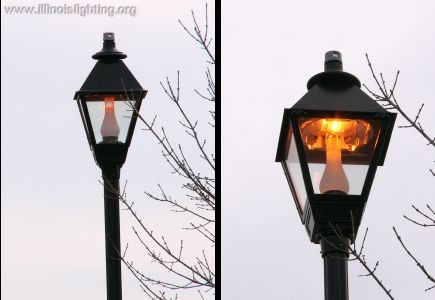
Responsible, efficient fixtures are available in both streamlined, modern designs and styles which replicate classic forms. The lamp on the left, for instance, is "antique" in style, but instead of placing its brilliant light bulb in plain view, it has the lamp recessed up in its lid, with a reflector to direct the illumination down and outward. (Although, note that this fixture's photoelectric switch is not functioning, and it is on in the daytime; lighting installations must be maintained to remain energy efficient!)
Similar "coachlight" fixtures are also available without the chimney or even the glass side panes which scatter light; those designs spray even less of their light off to the sides, concentrating it all on the illumination zone underneath them. A far cry from the wasteful, glaring fixture in the top photo, but with the same daytime charm.
Daytime VS. Night in Downtown Naperville
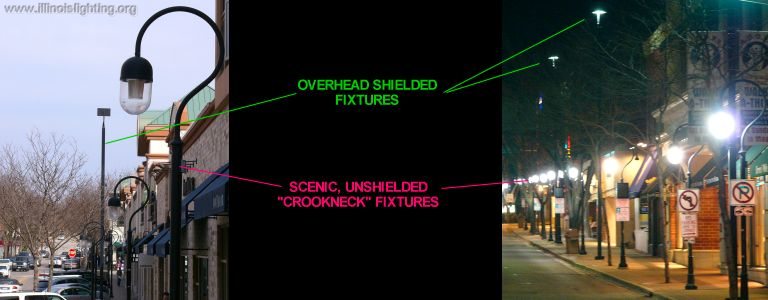
The above photos show the current choices for illuminating the downtown of Naperville, Illinois. Besides lights generally present under storefront overhangs and in doorways, the area has two sets of fixtures installed: On high poles, there are metal halide high intensity discharge lamps in efficient, box-type luminaires. On lower poles, much more closely spaced, are completely unshielded metal halide hanging globe fixtures, apparently selected for their daytime charm. As can be seen in the nighttime photo, the majority of the sidewalk illumination comes from the stores' fixtures, and the overhead lights provide lighting for the street. The decorative fixtures mainly provide an overabundance of glare, installed apparently to light up the remainder of the universe. (The nighttime photo was taken after midnight, with all the businesses closed, and no parking allowed in the downtown; the lights are on, but nobody is home...)
Even if you ignore safety and energy concerns, shouldn't the appearance of an area be as important at night as it is in the daytime? Isn't the better illumination provided by the fully-focused street lights downtown Clarendon Hills, Illinois, as shown in the photo below, more attractive than the direct glare shown in the photo above?
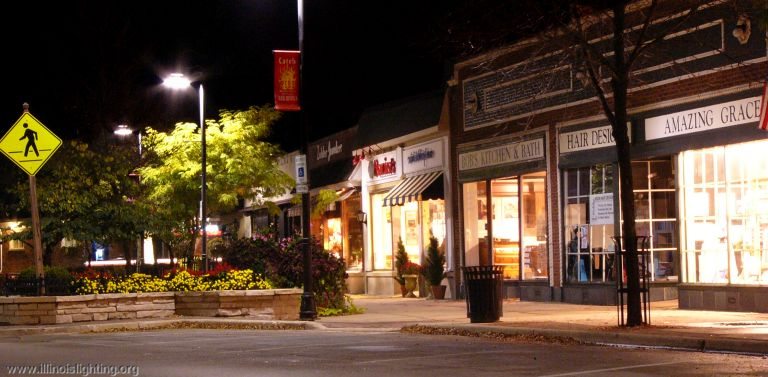
Illuminating Building Exteriors
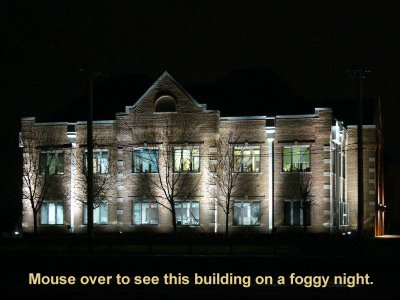
It is becoming more and more popular for both home and business owners to "show off" their property by illuminating part or all of building exteriors at night. In some cases, there is some overlap with security concerns, but for the most part, the practice is done to get attention.
While it could be argued whether or not any such vanity lighting is simply a waste of energy, there is no question that some methods of doing it are more harmful to the environment than others.
Spot and flood lights are usually used for building illumination. "Uplighting" consists of placing the fixtures down low, and pointing them upwards to the building facade. "Downlighting" refers to placing the fixtures up high, on the building eaves or separate poles, and shining them down on to the structure. Either type of illumination can cause glare and light trespass if the fixtures are not properly installed and shielded. Uplighting also frequently allows stray light to shine past the building's eaves, causing skyglow ("light pollution").
Commercial buildings are also often illuminated at night from the inside out, by leaving interior lights on to shine out through windows. This practice is often done more for vanity than safety or security, and the outward light spill can have as serious environmental effects in the surrounding area as exterior lighting can; it also unnecessarily consumes large amounts of electricity.
Illuminating Signs & Billboards
Signs serve as a form of advertising to get people's attention, and businesses have found that light at night can be a great attention getter. If your goal is to stand out from the other advertisers, it is tempting to out-do, or in this case, out-light your competitors. Out and out "wars" for bigger, flashier, brighter signage can result; and the nighttime environment can suffer, with excess distraction to drivers and pedestrians, unsafe glare, and severe light trespass. Municipalities which have adopted strict sign size, height & placement regulations have found that uniform, modest signage greatly improves neighborhood appearance; sign lighting standards should be included in sign regulations.

Signage can be illumninated in three basic manners: Exterior lights shining down on the sign face, exterior lights shining up on the sign face ("downlighting" or "uplighting", as in the building lighting described above), or with internal light which shines out of the sign. Any type of sign lighting, if improperly engineered, can spill excess or stray light into the environment. The billboards in the photo on the left feature wasteful uplighting fixtures which spray large amounts of their output up into the sky as light pollution and out into the surrounding neighborhood as glare.
Hours which business signage may be illuminated can be regulated, too; building or roadway signage lighting may be allowed only during business hours, or face a general curfew time for closed businesses. Lighting which flashes, or which features moving displays of images or words, can be dangerously distracting to drivers; for public safety concern, this type of display, while it is becoming more popular, should probably be condemned in most applications near to roadways.

The new generation of digital display signage presents its own set of lighting concerns. The billboard in the photo on the right features a digital display on the left face, and a traditional uplighted sign on the right one. To be visible in the sunlight, the output of the digital display must be extremely bright. If operated at dusk or at night at that same light output level, the sign will be glaringly bright; such signage must automatically adjust its light output depending on the amount of daylight present. Light output from luminous displays is normally measured in "nits"; while a sign needs to emit as much as 5,000 nits to be seen in full sunlight, less than 1/25 of that output is needed or desirable at night.
See the paper "Digital Billboards: New Regulations for New Technology" elsewhere on this website for more dicussion of the enviriomental and safety impacts of digital billboards.
Area lights, building lights, signage: Each and every form of artificial illumination which we use needs to be carefully scrutinized, asking whether it improves our communities (or degrades them), is being done efficiently (or wastefully), and if it is really necessary at all. Light fixtures, no matter what their external style, must be chosen with efficiency and their ability to put their light output only where it is needed as the features of top priority.
|
|








